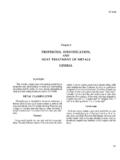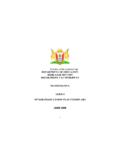Transcription of The World Health Organization’s WHOQOL-BREF quality of ...
1 quality of Life Research 13: 299 310, 2004. 299. 2004 Kluwer Academic Publishers. Printed in the Netherlands. The World Health Organization's WHOQOL-BREF quality of life assessment : psychometric properties and results of the international eld trial A Report from the WHOQOL Groupq Skevington1, M. Lotfy2 & O'Connell1. 1. WHO Centre for the Study of quality of Life, Department of Psychology, University of Bath, Bath, UK (E- mail: 2 Department of Mental Health and Substance Dependence, World Health Organisation, Geneva, Switzerland Accepted in revised form 5 March 2003. Abstract quality of life (QOL) assessments that are easily administered and which do not impose a great burden on the respondent are needed for use in large epidemiological surveys, clinical settings and clinical trials. Using data from the WHOQOL-BREF eld trials, the objectives of this work are to examine the performance of the WHOQOL-BREF as an integrated instrument, and to test its main psychometric properties .)
2 The WHOQOL-BREF is a 26-item version of the WHOQOL-100 assessment . Its psychometric properties were analysed using cross-sectional data obtained from a survey of adults carried out in 23 countries (n 11,830). Sick and well respondents were sampled from the general population, as well as from hos- pital, rehabilitation and primary care settings, serving patients with physical and mental disorders and with respect to quotas of important socio-demographic variables. The WHOQOL-BREF self- assessment was completed, together with socio-demographic and Health status questions. Analyses of internal consistency, item total correlations, discriminant validity and construct validity through con rmatory factor analysis, indicate that the WHOQOL-BREF has good to excellent psychometric properties of reliability and per- forms well in preliminary tests of validity. These results indicate that overall, the WHOQOL-BREF is a sound, cross-culturally valid assessment of QOL, as re ected by its four domains: physical, psychological, social and environment.
3 Key words: assessment , Cross-cultural, quality of life, WHOQOL-BREF . Introduction published quality of life (QOL) measures but there is still a lack of consensus among researchers Increasingly, Health care planners are recognizing about its de nition and this is re ected in the that measures of disease alone are insu cient de- choice of items for their instruments. terminants of Health status. Over the past decades, The WHO de nes QOL as an individual's per- two classes of complementary Health status mea- ception of their position in life in the context of the sures have emerged to ll the information gap culture and value systems in which they live, and in objective measures of functional Health status and relation to their goals, expectations, standards and subjective measures of Health and well-being (for concerns' [5]. In measuring QOL therefore, the reviews see Refs. [1 4]). These measures are multi- WHOQOL Group takes the view that it is im- level and multi-dimensional.
4 There are many portant to know how satis ed or bothered people are by important aspects of their life, and this in- q See Appendix 1 for details. terpretation will be a highly individual matter. The 300. World Health Organisation quality of Life as- an integrated instrument. For this reason, fresh sessment the WHOQOL-100 is a cross-cultur- data needed to be collected. In this study we pre- ally valid assessment of well-being. assessment is sent new survey data that represent the rst eld operationalized through 100 items representing 25 trial of the WHOQOL-BREF that seeks to con- facets organised in six domains [6, 7]. The tool was rm and extend information about the properties developed through a collaboration of 15 sites of the short form as a whole. Speci cally we aimed around the World working in their own national to assess item response distributions, internal language. Centres simultaneously used common consistency reliability and item scale correlations protocols that were agreed through international with other aspects of construct and discriminant consensus at each stage of development process.
5 Validity. Evidence of test retest reliability for the The WHOQOL collaboration pooled information WHOQOL-BREF is already known [9]. It was throughout the project and this procedure not only predicted that sick participants would report permits a high level of semantic and conceptual poorer QOL than well participants but no pre- equivalence to be achieved between language ver- dictions were made for other socio-demographic sions but also creates a fast track' to the rapid and centre di erences. establishment of multi-lingual instruments [7]. This new procedure whereby centres work simul- taneously on the same stage of instrument devel- Methods opment, pooling their ideas and results centrally (through WHO Geneva) and communicating with Design each other to achieve equivalence has been de- scribed as a spoke-wheel' methodology, through Data for the WHOQOL-BREF eld trial were analogy with the spokes and hub of a bicycle wheel collected using a cross-sectional design in 24 cen- [8].
6 Tres representing 23 countries. The centres were The WHOQOL-BREF is being developed as a drawn from countries in all the WHO Regions of short version of the WHOQOL-100 for use in situ- the World , as well as from diverse cultures and ations where time is restricted, where respondent di erent levels of socio-economic development. burden must be minimised and where facet-level Data were contributed from eld sites in Argen- detail is unnecessary with large epidemiologi- tina, Australia, Brazil, Bulgaria, China, Croatia, cal surveys and some clinical trials. Using data Germany, Greece, Hungary, Israel, Italy, India: from 15 centres collected for the WHOQOL-100 Madras and New Delhi, Japan, Malaysia, Neth- eld trials, items for the WHOQOL-BREF were erlands, Nigeria, Norway, Romania, Russia, selected for their ability to explain a substantial Spain, Turkey, United Kingdom, United States. proportion of variance within their parent facet Data collection methods were similar to interna- and domain, for their relationship with the overall tionally agreed protocols designed during the de- WHOQOL model and for their discriminant va- velopment of the WHOQOL-100 [6, 7].
7 Lidity [9]. Analysis of these extracted items showed Adult participants (adult was culturally de ned). that a four-factor structure best tted the data [9]. were recruited from a variety of in-patient and out- Although this contrasted with the original concept patient Health care facilities, and from the general of a 6-domain model for the WHOQOL, it was population. Using a common and consensually consistent with empirical results from the previous agreed protocol, quota sampling was used to WHOQOL-100 eld trials [8]. Based on these re- structure the sample so that equal numbers of each sults, the WHOQOL-BREF was developed in the gender and the two age groups (bisected at context of four domains of QOL: physical, psy- 45 years) were targeted. Recruitment would span chological, social and environment [9]. Although the continua of the adult age range, four educa- extensive analysis had been carried out on the tional levels and types of marital status.
8 Well WHOQOL-100 eld trial data to reduce items and samples were targeted similarly. The sites aimed to assess the preliminary psychometric properties of a recruit sick participants from all the main groups of short form [9], this extracted data was insu cient Health care users but did not use a quota for di- to con rm the WHOQOL-BREF 's properties as agnosis or severity. Wellness or sickness was de- 301. ned by self-report, from diagnostic categories as- usually for reasons of literacy or disability. Stan- signed by Health professionals, and with reference dard instructions, socio-demographic details and to contextual knowledge about (non) patient status an item on current Health status were completed relating to the nature of the population(s) ap- before answering the 26 items of the WHOQOL- proached in collection sites set up by each centre. BREF. Together the centres would obtain a richly heter- During development of the WHOQOL-100, ogeneous sample of sick people covering 28 groups four types of 5-point Likert interval scale were of physical or mental Health problems (linked to designed and tested to re ect intensity, capacity, ICD-10 categories) and with varying levels of dis- frequency and evaluation, and one of these was ease severity and functioning.
9 A fully structured attached to each item [10]. These response scales design and common protocol was not feasible for were also used in the WHOQOL-BREF . Items these variables due to an absence of relevant na- inquire how much', how completely', how often', tional statistics in some parts of the developing how good' or how satis ed' the respondent felt in World , and limited resources for research. the last 2 weeks; di erent response scales are dis- tributed across the domains [10, 11]. The transla- tion process used by the WHOQOL Group to Instrument develop linguistically and culturally appropriate new versions of the measure has been revised and The WHOQOL-BREF is an abbreviated 26-item updated from the WHO standard procedures and version of the WHOQOL-100 containing items is reported elsewhere [6, 12, 13]. that were extracted from the WHOQOL-100 eld trial data. The WHOQOL-BREF contains one Analysis item from each of the 24 facets of QOL included in the WHOQOL-100, plus two benchmark' items Frequency, reliability and correlational analyses from the general facet on overall QOL and general Frequency analyses were performed to assess re- Health (not included in the scoring) (see Table 1).
10 Sponse distributions at the item level, globally and The facets were originally subsumed within one of by country. In line with the WHOQOL-100 pro- six domains but factor analysis of the WHOQOL- cedure, problematic items were identi ed as those 100 indicated that Domain 1 could be merged with where the response distribution was skewed such Domain 3 (physical with independence), and Do- that fewer than 10% of responses fell in any two main 2 with Domain 6 (psychological with spiri- adjacent scale points for at least 12 of the 24. tuality, religion and personal beliefs) thereby centres. Internal consistency was assessed using creating four domains of QOL [8]. Similar results Cronbach's a and the contribution of each item to were found during the extraction of data for the the total a. The average inter-item correlations WHOQOL-BREF [9] which is currently scored in for domains, and correlation of items with their four domains: Domain 1: Physical Health , Domain intended domain (using corrected item total cor- 2: Psychological, Domain 3: Social relations and relations) were also calculated.










